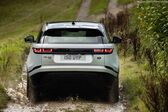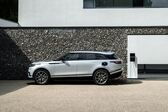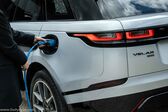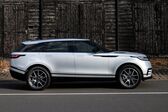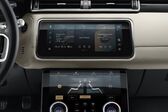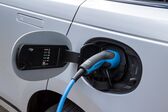General data |
|---|
| Generation | Range Rover Velar (facelift 2020) |
|---|
| Modification | 2.0 P250 (250 Hp) AWD Automatic |
|---|
| Start of production | September, 2020 year |
|---|
| Powertrain Architecture | Internal Combustion engine |
|---|
| Body type | SUV |
|---|
| Seats | 5 |
|---|
| Doors | 5 |
|---|
| Fuel Type | Petrol (Gasoline) |
|---|
Fuel consumption (economy), emissions |
|---|
| Fuel consumption - combined | 7.7 l/100 km |
|---|
| CO2 emissions | 174 g/km |
|---|
| Emission standard | Euro 6 |
|---|
Performance specs |
|---|
| Acceleration 0 - 100 km/h (0 - 62 mph) | 7.5 sec |
|---|
| Acceleration | 7.1 sec |
|---|
| Maximum speed | 217 km/h |
|---|
| Weight-to-power ratio | 7.5 kg/Hp, 133.3 Hp/tonne |
|---|
Engine technical data |
|---|
| Power | 250 Hp @ 5000 rpm. |
|---|
| Power per litre | 125.2 Hp/l |
|---|
| Torque | 365 Nm @ 1300-4500 rpm. |
|---|
| Engine location | Front, Longitudinal |
|---|
| Engine displacement | 1997 cm3 |
|---|
| Number of cylinders | 4 |
|---|
| Position of cylinders | Inline |
|---|
| Cylinder Bore | 83.01 mm |
|---|
| Piston Stroke | 92.28 mm |
|---|
| Compression ratio | 10.5 |
|---|
| Number of valves per cylinder | 4 |
|---|
| Fuel System | Direct injection |
|---|
| Engine aspiration | Naturally aspirated engine |
|---|
| Engine systems | Start & Stop SystemParticulate filter |
|---|
| Power | Electric Steering |
|---|
Suspension and brakes specs |
|---|
| Drivetrain Architecture | The Internal combustion engine (ICE) drives the front wheels permanently, and the rear wheels are driven through an electrically or mechanically operated clutch if necessary. |
|---|
| Drive wheel | All wheel drive (4x4) |
|---|
| Number of Gears (automatic transmission) | 8 |
|---|
| Front suspension | Double wishbone |
|---|
| Rear suspension | Multi-link independent |
|---|
| Front brakes | Ventilated discs, 350 mm |
|---|
| Rear brakes | Ventilated discs, 325 mm |
|---|
| Assisting systems | ABS (Anti-lock braking system) |
|---|
| Steering type | Steering rack and pinion |
|---|
Dimensions |
|---|
| Length | 4797 mm |
|---|
| Width | 2041 mm |
|---|
| Width | 2147 mm |
|---|
| Height | 1678-1683 mm |
|---|
| Wheelbase | 2874 mm |
|---|
| Front track | 1640-1644 mm |
|---|
| Rear (Back) track | 1657-1663 mm |
|---|
| Front overhang | 834 mm |
|---|
| Rear overhang | 1089 mm |
|---|
| Ride height | 205-251 mm |
|---|
| Drag coefficient (Cd) | 0.32 |
|---|
| Minimum turning circle (turning diameter) | 11.94 m |
|---|
| Approach angle | 22.5-27.5° |
|---|
| Departure angle | 24.8-29.5° |
|---|
| Ramp angle | 18.3-23.5° |
|---|
| Wading depth | 530-580 mm |
|---|
Weights, volume and space |
|---|
| Kerb Weight | 1875 kg |
|---|
| Trunk (boot) space - minimum | 748 l |
|---|
| Trunk (boot) space - maximum | 1811 l |
|---|
| Fuel tank capacity | 82 l |
|---|
| Permitted trailer load with brakes (12%) | 2400 kg |
|---|
| Permitted trailer load without brakes | 750 kg |
|---|
 Land Rover Range Rover Velar (facelift 2020) 2.0 P250 (250 Hp) AWD Automatic has been in production since 2020 - present. Cars comes in SUV body types and can be suited with Petrol (Gasoline) engine types with a volume of 2L liters, engines produces a power of 250 Hp.
Land Rover Range Rover Velar (facelift 2020) 2.0 P250 (250 Hp) AWD Automatic has been in production since 2020 - present. Cars comes in SUV body types and can be suited with Petrol (Gasoline) engine types with a volume of 2L liters, engines produces a power of 250 Hp.




